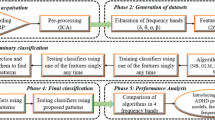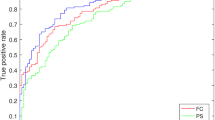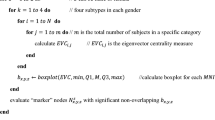Abstract
The diagnosis of attention-deficit hyperactivity disorder (ADHD) is based on the health history and on the evaluation of questionnaires to identify symptoms. This evaluation can be subjective and lengthy, especially in children. Therefore, a biomarker would be of great value to assist mental health professionals in the process of diagnosing ADHD. Event-related potential (ERP) is one of the most informative and dynamic methods of monitoring cognitive processes. Previous works suggested that specific sets of ERP-microstates are selectively affected by ADHD. This paper proposes a new methodology for the ERP-microstate analysis and identification of ADHD patients based on complex networks to model the microstate topographic maps. The analysis of global and local features of ERP-microstate networks revealed topological differences between ADHD and healthy control. The classification using a neural network with a single hidden layer resulted in an average accuracy of 99.72% in binary classification and 99.31% in the classification of ADHD subtypes. The results were compared to the power band spectral densities and the energy of wavelet coefficients. The temporal features of ERP-microstates, such as frequency of occurrence, duration, coverage, and transition probabilities, were also evaluated for comparison proposes. Overall, the selected topological features of ERP-microstate networks derived from the proposed method performed significantly better classification results. The results suggest that topological features of ERP-microstate networks are promising to identify ADHD and its subtypes with a neural network model compared to power band spectrum density, wavelet transform, and temporal features of ERP-microstates.
Graphical abstract




Similar content being viewed by others
Data availability
The datasets analyzed during the current study are available in the OSF repository (https://osf.io/6594x/).
References
Thomas R, Sanders S, Doust J, Beller E, Glasziou P (2015) Prevalence of attention-deficit/hyperactivity disorder: a systematic review and meta-analysis. Pediatrics 135(4):994–1001
Song P, Zha M, Yang Q, Zhang Y, Li X, Rudan I (2021) The prevalence of adult attention-deficit hyperactivity disorder: a global systematic review and meta-analysis. J Global Health 11
Association AP et al (2022) Diagnostic and statistical manual of mental disorders fifth edition, text revision (DSM-5-TR). Author
Ahmadi N, Mohammadi MR, Araghi SM, Zarafshan H (2014) Neurocognitive profile of children with attention deficit hyperactivity disorders (ADHD): a comparison between subtypes. Iran J Psychiatry 9(4):197
Ghanizadeh A (2011) Overlap of ADHD and oppositional defiant disorder DSM-IV derived criteria. Arch Iran Med 14(3):179
Dubreuil-Vall L, Ruffini G, Camprodon JA (2020) Deep learning convolutional neural networks discriminate adult ADHD from healthy individuals on the basis of event-related spectral EEG. Front Neurosci 14
Vahid A, Bluschke A, Roessner V, Stober S, Beste C (2019) Deep learning based on event-related EEG differentiates children with ADHD from healthy controls. J Clin Med 8(7):1055
Tosun M (2021) Effects of spectral features of EEG signals recorded with different channels and recording statuses on ADHD classification with deep learning. Phys Eng Sci Med 44(3):693–702
Férat V, Arns M, Deiber M-P, Hasler R, Perroud N, Michel CM, Ros T (2022) Electroencephalographic microstates as novel functional biomarkers for adult attention-deficit/hyperactivity disorder. Biol Psychiatry Cogn Neurosci Neuroimaging 7(8):814–823
Jahanshahloo HR, Shamsi M, Ghasemi E, Kouhi A (2017) Automated and ERP-based diagnosis of attention-deficit hyperactivity disorder in children. J Med Signals Sens 7(1):26
Mueller A, Candrian G, Kropotov JD, Ponomarev VA, Baschera G-M (2010) Classification of ADHD patients on the basis of independent ERP components using a machine learning system. In: Nonlinear Biomedical Physics, vol 4, pp 1–12. Springer
Lehmann D, Ozaki H, Pal I (1987) EEG alpha map series: brain micro-states by space-oriented adaptive segmentation. Electroencephalogr Clin Neurophysiol 67(3):271–288
Pascual-Marqui RD (2002) Standardized low resolution brain electromagnetic tomography (sLORETA): Technical details 24 Suppl D:5–12
Lehmann D (2010) Multimodal analysis of resting state cortical activity: what does FMRI add to our knowledge of microstates in resting state EEG activity?: Commentary to the papers by britz et al. and musso et al. in the current issue of neuroimage. NeuroImage 52(4):1173–1174
Pascual-Marqui RD, Michel CM, Lehmann D (1995) Segmentation of brain electrical activity into microstates: model estimation and validation. IEEE Trans Biomed Eng 42(7):658–665
Albrecht B, Uebel-von Sandersleben H, Wiedmann K, Rothenberger A (2015) ADHD history of the concept: the case of the continuous performance test. Curr Dev Disord Rep 2(1):10–22
Brandeis D, van Leeuwen TH, Steger J, Imhof K, Steinhausen H-C (2002) Mapping brain functions of ADHD children. In: International Congress Series, vol 1232, pp 649–654. Elsevier
Meier NM, Perrig W, Koenig T (2012) Neurophysiological correlates of delinquent behaviour in adult subjects with ADHD. Int J Psychophysiol 84(1):1–16
Michel CM, Koenig T, Brandeis D, Gianotti LR, Wackermann J (2009) Electrical neuroimaging, 1st edn. Cambridge University Press, ???
Khanna A, Pascual-Leone A, Farzan F (2014) Reliability of resting-state microstate features in electroencephalography.(research article). PLoS ONE 9(12)
Karalunas SL (2022) Electroencephalographic biomarkers in psychiatry-how do we make good on promises? Biological Psychiatry: Cognitive Neuroscience and Neuroimaging 7(8):752–753
Koenig T, Kottlow M, Stein M, Melie-Garcia L (2011) Ragu: a free tool for the analysis of EEG and MEG event-related scalp field data using global randomization statistics 2011:938925
Poulsen AT, Pedroni A, Langer N, Hansen LK (2018) Microstate EEGlab toolbox: an introductory guide. bioRxiv
Hu L, Zhang Z (2019) EEG signal processing and feature extraction. Springer, Singapore
de Vico Fallani F, Richiardi J, Chavez M, Achard S (2014) Graph analysis of functional brain networks: practical issues in translational neuroscience. Phil Trans R Soc B Biol Sci 369(1653):20130521
Telesford QK, Simpson SL, Burdette JH, Hayasaka S, Laurienti PJ (2011) The brain as a complex system: using network science as a tool for understanding the brain. Brain connectivity 1(4):295–308
Rubinov M, Sporns O (2010) Complex network measures of brain connectivity: uses and interpretations. Neuroimage 52(3):1059–1069
Perrin F, Pernier J, Bertrand O, Echallier J (1989) Spherical splines for scalp potential and current density mapping. Electroencephalogr Clin Neurophysiol 72(2):184–187
Cohen MX (2014) Analyzing neural time series data: theory and practice. MIT press, USA
Nunez PL, Srinivasan R et al (2006) Electric fields of the brain: the neurophysics of EEG, 2nd edn. Oxford University Press, USA, ???
Michel CM, Koenig T (2017) EEG microstates as a tool for studying the temporal dynamics of whole-brain neuronal networks: a review
Zhang M, Zhou H, Liu L, Feng L, Yang J, Wang G, Zhong N (2018) Randomized EEG functional brain networks in major depressive disorders with greater resilience and lower rich-club coefficient. Clin Neurophys 129(4):743–758
Mann HB, Whitney DR (1947) On a test of whether one of two random variables is stochastically larger than the other. Ann Math Stat 18(1):50–60
Snoek J, Larochelle H, Adams RP (2012) Practical Bayesian optimization of machine learning algorithms. arXiv preprint. arXiv:1206.2944
Baratloo A, Hosseini M, Negida A, El Ashal G (2015) Part 1: simple definition and calculation of accuracy, sensitivity and specificity. Emergency 3(2):48–49
Welch P (1967) The use of fast Fourier transform for the estimation of power spectra: a method based on time averaging over short, modified periodograms. IEEE Trans Audio Electroacoust 15(2):70–73
Heinrich H, Moll G, Dickhaus H, Kolev V, Yordanova J, Rothenberger A (2001) Time-on-task analysis using wavelet networks in an event-related potential study on attention-deficit hyperactivity disorder. Clin Neurophys 112(7):1280–1287
Jain A, Zongker D (1997) Feature selection: evaluation, application, and small sample performance. IEEE Transactions Patt Anal Mach Intell 19(2):153–158
Rieger K, Diaz Hernandez L, Baenninger A, Koenig T (2016) 15 years of microstate research in schizophrenia - where are we? A meta-analysis. Front Psychiatry 7:22
Chennu S, Finoia P, Kamau E, Allanson J, Williams GB, Monti MM, Noreika V, Arnatkeviciute A, Canales-Johnson A, Olivares F et al (2014) Spectral signatures of reorganised brain networks in disorders of consciousness. PLoS Comput Biol 10(10):1003887
Zillessen K, Scheuerpflug P, Fallgatter A, Strik W, Warnke A (2001) Changes of the brain electrical fields during the continuous performance test in attention-deficit hyperactivity disorder-boys depending on methylphenidate medication. Clin Neurophys 112(7):1166–1173
Moghaddari M, Lighvan MZ, Danishvar S (2020) Diagnose ADHD disorder in children using convolutional neural network based on continuous mental task EEG. Comput Methods Prog Biomed 197
He L, Hu D, Wan M, Wen Y, Von Deneen KM, Zhou M (2015) Common Bayesian network for classification of EEG-based multiclass motor imagery BCI. IEEE Trans Syst Man Cybern Sys 46(6):843–854
Hesse W, Möller E, Arnold M, Schack B (2003) The use of time-variant EEG granger causality for inspecting directed interdependencies of neural assemblies. J Neurosci Methods 124(1):27–44
Funding
The authors thank the Programa de Pós-Graduação em Engenharia Elétrica (PPGEE - UFES) and the financial support for the research from the project of the Conselho Nacional de Desenvolvimento Científico e Tecnológico (CNPq) and Fundação de Amparo à Pesquisa do Espírito Santo (FAPES), number 598/2018.
Author information
Authors and Affiliations
Corresponding author
Ethics declarations
Conflict of interest
The authors declare no competing interests.
Additional information
Publisher's Note
Springer Nature remains neutral with regard to jurisdictional claims in published maps and institutional affiliations.
Rights and permissions
Springer Nature or its licensor (e.g. a society or other partner) holds exclusive rights to this article under a publishing agreement with the author(s) or other rightsholder(s); author self-archiving of the accepted manuscript version of this article is solely governed by the terms of such publishing agreement and applicable law.
About this article
Cite this article
Alves, L.M., Côco, K.F., De Souza, M.L. et al. Identifying ADHD and subtypes through microstates analysis and complex networks. Med Biol Eng Comput 62, 687–700 (2024). https://doi.org/10.1007/s11517-023-02948-2
Received:
Accepted:
Published:
Issue Date:
DOI: https://doi.org/10.1007/s11517-023-02948-2




